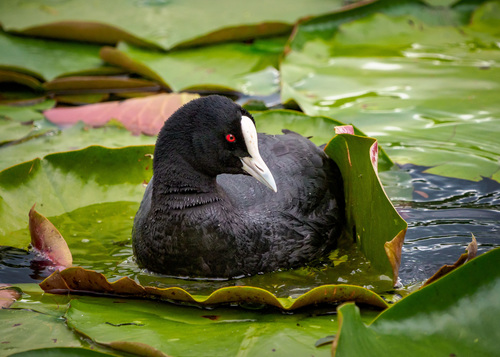
Eurasian Coot
The Eurasian Coot (Fulica atra) is a distinctive waterbird known for its dark plumage and prominent white frontal shield. It plays a vital role in wetland ecosystems, primarily as a consumer of aquatic plants and invertebrates, influencing vegetation structure and nutrient cycling. While not particularly celebrated in culture, it's a familiar and easily recognizable species across its broad range, offering a common point of connection with nature for many people in Europe, Asia, Africa, and Australasia.
36-42 cm
Length
70-80 cm
Wingspan
Least Concern
Conservation Status
Distribution
The Eurasian Coot has a vast distribution, found across Europe, Asia, Africa, and Australasia. It breeds in temperate and subtropical regions, with many populations migrating south for the winter. Its altitudinal range extends from sea level to high-altitude lakes in some areas.
Lifespan
Typically 5-10 years in the wild, but can live longer in captivity.
Eurasian Coot's Habitat
Habitat Types
Freshwater lakes, Ponds, Reservoirs, Slow-flowing rivers, Marshes, Brackish lagoons
Climate Zones
Temperate, Subtropical, Tropical (in parts of its range)
Adaptations
Eurasian Coots have lobed toes, which provide excellent propulsion in water and allow them to walk on soft mud and floating vegetation. They are also well-adapted to diving for food.
Variations
Several subspecies are recognized, differing slightly in size and plumage details. For example, *Fulica atra australis* is found in Australia and New Zealand.
Appearance
Breeding Plumage
Plumage is largely consistent year-round.
Seasonal Feather Changes
Minor changes in the brightness of the frontal shield may occur.
Sex Based Plumage Differences
Minimal; males and females are very similar in appearance.
Notable Features
Prominent white frontal shield, Black plumage with a slight greyish tinge, Red eyes, Lobed toes (not webbed)
Diet and Feeding
Primary Foods
Aquatic plants (e.g., algae, pondweeds), Invertebrates (e.g., insects, mollusks, crustaceans), Seeds, Small fish (occasionally)
Foraging Behavior
Eurasian Coots are versatile feeders. They dabble at the surface, dive underwater, and graze on land near the water's edge. They often upend like ducks to reach submerged vegetation.
Specializations
Their lobed toes are a key adaptation for both swimming and walking on unstable substrates. Their bill is well-suited for grasping and tearing vegetation.
Seasonal Diet Variations
Diet can shift depending on food availability. In winter, they may consume more seeds and invertebrates when aquatic plant growth is reduced.
Behavior
Social Structure
Eurasian Coots are often found in flocks, especially outside the breeding season. During breeding, they become territorial and defend their nesting area.
Communication
Loud, sharp calls ('kowp' or 'kyow'), Hissing sounds when threatened, Visual displays (e.g., raising the frontal shield)
Migration
Many populations are migratory, moving to warmer areas for the winter. Others are resident or only undertake short-distance movements.
Territorial or Group Behaviors
Highly territorial during breeding, aggressively defending their nests and young. Outside of breeding, they form large flocks, sometimes numbering in the hundreds or even thousands.
Conservation
Threats
Habitat loss and degradation (due to drainage, pollution, and development), Hunting (in some regions), Disturbance from human activities, Lead poisoning (from ingestion of lead shot)
Protection Programs
Wetland conservation and restoration initiatives, Regulation of hunting in some areas, Monitoring of populations
Local National Laws
Protected under various national and international laws, including the Agreement on the Conservation of African-Eurasian Migratory Waterbirds (AEWA).
Population Trend
Stable
Population Estimates
Global population estimated to be in the millions.
Interesting Facts
Coots are known for their aggressive behavior.
They will fiercely defend their territories and chicks, even attacking larger birds or mammals.
Their chicks have brightly colored heads.
The chicks have red and blue skin on their heads, which fades as they mature.
They are surprisingly strong fliers.
Despite their somewhat clumsy appearance on land and water, they can migrate long distances.
They build decoy nests.
To confuse predators, they may build more nests than are actually used.
Faqs about Eurasian Coot
Are Eurasian Coots related to ducks?
No, they are not ducks. They belong to the rail family (Rallidae), which also includes rails and crakes.
What is the white patch on their head?
That is called a frontal shield. Its exact function is not fully understood, but it may play a role in display and communication.
Can Eurasian Coots walk on land?
Yes, they can walk and run on land, although they are more agile in the water. Their lobed toes help them walk on soft mud and vegetation.
Do Eurasian Coots migrate?
Yes, many populations are migratory, traveling south for the winter. However, some populations are resident year-round.
Are Eurasian Coots endangered?
No, the Eurasian Coot is classified as Least Concern by the IUCN. They have a large population and a wide distribution.
Copyright @ Nature Style Limited. All Rights Reserved.
 English
English